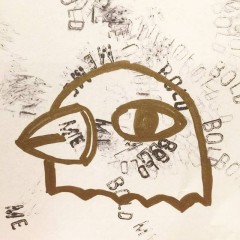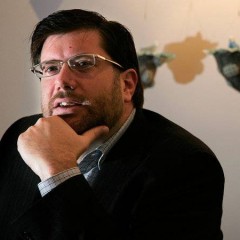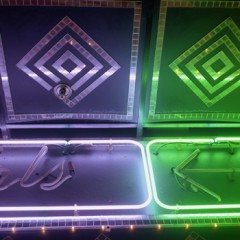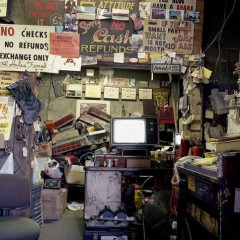I interviewed Lisa Kereszi by email to write a book review on “Joe’s Junk Yard,” which appeared in Artblog in early November. Artblog asked if I could do a Q and A with the material that was leftover, so I dove back into the file, what southerner’s call “the gettin’ place,” and patched together an edited version of our email correspondence. Lisa and I had only met briefly before this interview, so it’s a record of searching for common ground through family and influences as much as it’s an interview. Lisa generously answered all my questions, the review wouldn’t have been possible without her candid responses.
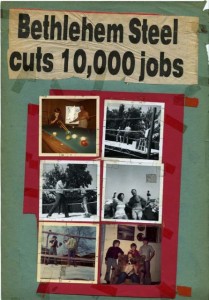
Elizabeth Johnson: Your book has a strong sense of place and yet escape from that place. Also brings up all the paths not available, not taken. My family worked first in steel mills for Bethlehem Steel in Pittsburgh. My grandfather was a tyrant and very scary too. He operated the overhead cranes in the mill. No one could manage him. I come from a family of bossy people on my father’s side, the Johnsons were Swedes. My mom is the Irish junk-a-holic. Mom nurtures the world, all the animals, plants and trees blossom under her care. Four cats at the moment and a dog. She wanted to protect the garbage man from broken glass, so, well we can’t throw that away! Our biggest arguments are over clearing clutter. But each time I walk in her house, I see the newest, most compelling PILE ever and I think–genius. Yet, I grow weak there, I’m overcome. I lose things, things may never surface again. I can’t concentrate, nothing gets done, there’s an overall lingering sense of procrastination. The clutter is speaking as Larry Fink says. In my Mom’s case it tells the story of not being taken care of by her Mom, an alcoholic.
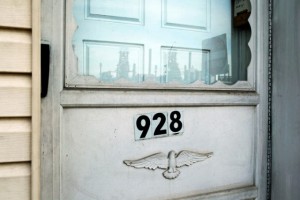
Lisa Kereszi: Your mom’s house sounds great. I love that you have so many connections with the book – so many people have so many threads to follow, I am hearing: family, cars, hoarding – or collecting. I am in a purging mode right now. All this sorting is a pain….Speaking of pain – the losses really are more my dad’s, my grandparents’ than anything. I feel like it’s all secondhand pain, which still is felt deeply and alters your view of things.
EJ: Lisa, this is good to know. If it’s secondhand pain, that’s why you can work with it effectively in photographs. Is it possible that the secondary pain, your Grandfather’s and Father’s, is the “central” thing that you place in the middle of the picture? I see my Mom’s pain this way. She has a center counter, in
the kitchen, where everything lands at some point or another. Cat medicine, ooh sticky!, flour, sugar, her medical receipts, “Where are my glasses?,” “Have you seen my letter opener?” (the letter opener turned up several months later). She has thrown out her car keys and left her hearing aids in hotels. It’s just my Mom, I love her. And when I see her genius for piling things together, (Mike Kelley had nothing on her!), I think of it as her emotional center, it has gravity. It pulls other things into it’s orbit. Is that analogous to your situation?
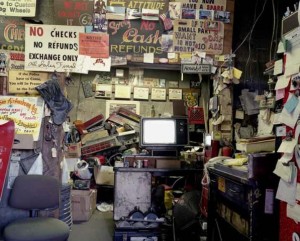
LK: Well, I am not opposed to you reading that much into the form of the picture, since form and content are intertwined, but I hadn’t thought of that, and I don’t feel like that’s the answer, when you said it. But, possibly, part of it. Maybe focusing intently on something keeps the demons at bay? Gravity, gravitas, etc… I don’t know; I think it’s more about pointing, and monumentalizing an object. Making trash into sculpture.
EJ: Dear Lisa, I’m looking at the use of the center by Bill Owens and William Eggleston. You probably teach these guys. Do you remember the article about Eggleston’s “Untitiled” or “Tricycle and Memphis 1970” where he puts a trike right in the center of the photo? It made a big impression at the time.
I’m comparing how your use of the center differs from their use of it. I think you may have a bit more space around the edges, more space to frame the subject, which gives a special feel, slight vertigo to the photos.
LK: Yes about Eggleston, whose book, Chromes, we looked at together in my undergraduate class. Yes about the tricycle picture, also about the red room with the lightbulb on the ceiling image of his. I would definitely say that Eggleston had a huge influence on me, also that Robert Adams’ picture of the woman in the middle of the window in the middle of the house – the light passes all the way through the windows, so she’s a silhouette. The center obsession, though I know it’s a no-no, is just a natural inclination, and could even, in a most basic and practical way, be caused by the rangefinder’s center-focusing screen, you know? (Although the Bicentennial rug one is 4×5, so that centered composition doesn’t come from the camera.)
EJ: I want to talk further about specific photographers. First of all, with Walker Evans and Robert Adams in your back pocket, you definitely have two opposing styles, like Larry (Fink) and Stephen (Shore). I’m talking about what Larry calls hot vs. cool. Or busy vs. easy on the eye, iconic, beautiful. So maybe you start with the documenting urge, then discover or frame the emotional hit. All supposition here, I’m trying to get how you construct the scene.
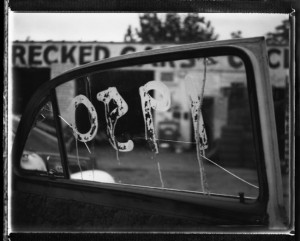
LK: Well, I guess I didn’t really discover the scrapbooks [her grandfather’s scrapbooks, which are the source of some of her photos in the book] until I was older, probably in or after college, after my grandfather had died. I would have seen some of the photos prior to that, in albums. I can’t say they definitely influenced me. I think my grandmother took most of the photos, by the way – or at least that’s what she says. I did work with these materials my first year in graduate school, though, and selected images from the books to make into my own artist book, and also into large diptychs and triptychs, one of which you see in the book, actually. I recall one of the critique panelists at Yale saying that the characters in the pictures reminded him of John Waters’s characters. That was a great compliment! Anybody’s (well almost anybody’s) family photos can have the occasional lucky break, but of course, I, and other viewers, do find ours particularly compelling. For example, there’s my grandfather’s family’s practice of taking photos at funerals. This is a very Eastern European (and Victorian) thing to do, but seems odd to many Americans today. He puts family pictures and funeral photographs and auto graveyard pics all together on one page in the scrapbooks. The connections are palpable.
I don’t see Walker Evans and Robert Adams as opposing styles, though Larry Fink and Stephen Shore surely are. In fact, if you look at Adams’s early work, it seems to me to clearly be influenced by Evans, in the straightforwardness as well as in subject choice – old clapboard buildings left to wither and get weathered. By the way, I’ve just found out that Walker Evans and I are both descended from the same New England colonist, John Lawrence, an ancestor of his who is mentioned in the biography of him by James Mellow, which is how my mom and I found the connection. He was my tenth great grandfather, and was Evans’s sixth, or seventh, great grandfather! So, my connection to him via DNA was not even known when I made the Lehigh Valley connections that I mention in the book. (Something I left out, but that I’ll tell you now, is that the street parallel to East Third in Bethlehem, directly behind my grandfather’s childhood home, was, get this, Evans St. You can’t make his stuff up.)
Anyway, when I teach, and during a guest lecture very recently at Bard, in fact, I speak about how lucky I have been to have top notch mentors and teachers, and how one can mimic their teachers and favorite artists – that’s how we might learn, learn something by their example. However, we must move on, gathering little bits of straw and trash from each of them in order to build our nest. Back to the lucky part – those mentors and teachers are (not exclusively) Stephen and Larry, Nan Goldin, Tod Papageorge, Greg Crewdson and Phillip Lorca diCorcia. My other influences include: Evans, Frank, Eggleston, Brassai, Arbus, Atget, also Hopper, John Waters, David Lynch, Martin Scorsese.
That busy vs centered thing- take the junkyard office pic as an example. Order out of chaos. I feel like I learned that from Stephen, though Larry does it too, but in a less quiet, more energetic and kinetic way. There’s a ton of stuff going on in the background, but the glowing white tv cinches all together. A white hole. A spirit. The spirit of Uncle Mark who killed himself in the office, amidst all that chaos of the family history, signified by the layers and amalgamation of decades of accumulated ephemera, postcards, pictures, attitudes on signs, etc… Does that make sense?
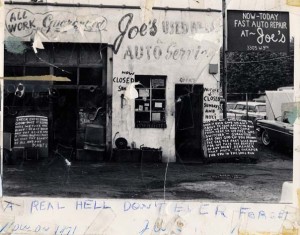
EJ: ….Looks like with this Junkyard series I can’t underestimate the importance of your family, the risks you’re taking picturing the personal story. My husband Matthew’s folks in KY have a tradition of slipping money in the dead person’s pocket, at the funeral. So weird, and substantial amounts! $25 or so. It is part of the God thing–you have witnesses always. One of them just happens to be omnipotent. But your family was not super religious correct?
LK: Incredible about slipping money into the pockets of the dead. Both grandparents on my dad’s side were raised Catholic, and probably pretty seriously so, as Slovenian/Hungarians and Italians, from what I have learned about both cultures. On my grandfather’s side, two of his sisters, in fact, were sent to become nuns before they were even about 16. Remained so their whole lives, dedicated to the Lord. There is also another nun in that side of the family – closer to Uncle Lou’s part of the family. My father went to Catholic school, and dropped out at 16 to work at the yard. The nuns hit him with a ruler. He pretty much rejected religion. However, his brother, Mark, who committed suicide in the 90s,and also my grandmother were/are big Evangelicals.
I remember going with them to this wacky place, the Christian Academy, as a kid, without my mom or dad. There were all the sad, defeated, sick and injured of the world there, speaking in tongues, hands held up high, rolling on the ground in ecstasy, singing Hallelujah. It was sort of a freak show… Uncle Mark brought his beliefs home with him. He threatened to throw a brick through the tv when I had an 80s hair band metal video on at some holiday. Also, I vividly remember something I still regret not photographing (I was not yet a photographer). He rejected the evil in the world, in his life, and brought all his “evil” belongings out and put them on a table to throw out. Why on a table though? Why not straight into trashbags? Who knows? Maybe he had to arrange them all out to see and do some ritual of exorcism before throwing into the garbage. It was covered with Dungeons and Dragons stuff, Mad Balls, Garbage Pail Kids cards and stickers, stupid monster crap. That really made an impression on me. What I am getting at is that my great-grandparents, and then my uncle and grandmother (but probably not Joe Sr.) were/are very religious. I am not. I don’t feel the need to be, though I can see why my grandmother does.
EJ: So was it a big deal when your Dad took over or had everyone shared the running of the joint [the junk yard]?
LK: Nah, everyone was in it the whole time. My uncle Mark floated in and out – was in the Navy for a while, wanted to be a prison guard for a while, had one of the bays made into a paint booth so he could have his part of the business be auto painting. I don’t think it really worked out. My grandmother’s brother helped out for a while, her mother helped invest, my grandfather’s mother made the initial investment, my dad’s cousin Ricky worked there for a while. And all the other Kerezsi’s (different spelling) had their own auto-related business on the same street, and also down around the corner. My mom was the bookkeeper. I found missing titles for a quarter apiece or something like that. There was no line drawn anywhere, except that Joe Sr’s brother’s (more successful) businesses were separate.
EJ: Did your grandfather leave LOTS of scrapbooks? Did they span his entire life? It makes sense, starting in a boxing career, to keep them and then maybe they morphed into diary. I love them as collages, and the clear taping is the masterstroke.
LK: Scrapbooks are in about a 1.5 feet deep pile. Some are themed according to each child, but some don’t make sense, and are maybe like Warhol’s Time Capsules, and possibly added to chronologically. He also wrote all over the walls at home, all over framed photos, anything he could get his permanent marker on. Some stuff is still not painted over in the house, in the basement. I have an iron cross, piece of metal painted gray, and he scribbled on it: “The Iron Cross We All Bear.” Crazy stuff.
EJ: Did the scrapbooks span his entire life?
LK: No, I was told by my grandmother that he only started making them in the wee hours of the night after his son Rocky was shot by police in 1973. Not sure that is 100% true, since there are pictures he wrote on that have 1971 scrawled on them in marker. She was mad that he tore up all the family albums to repurpose snapshots, cutting them, writing on them, tearing them, taping them, collaging them. I have found no albums, no negatives. They must have been lost in the fire in 1971, too. He always wrote on stuff, though. My aunt has this great old photo of my great-grandmother at age 17 in traditional Slovenian wedding garb, and there’s no getting it from her. She says that in the 70s, she rescued it from him. He had nailed this photo (that was mounted on copper or tin) to the wall, and wrote something really bizarro and dark on it in ballpoint pen, which she removed with alcohol.
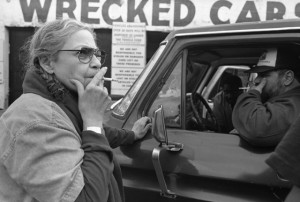
EJ: Did anyone else in the family, besides your grandma who took photos and painted dolls, do art projects?
LK: My grandmother’s mother was an artist, as well as a nurse, an RN. They were Sunday painters, oil, watercolor, arts and crafts. My grandmother’s porcelain dolls were pretty exquisite reproductions. The kiln is still in the basement, so are the molds. Back in the 1980s, her dolls sold for maybe $400, which seems like a lot back then. I was so proud she had a show at the local public library, dolls in glass cases, and that the baby dolls my sister and I “painted” were included.
EJ: Matthew and I saw On the Bowery recently–such a great film. These films and your work both pivot on failure, unique characters and significant change. Also I’m looking for those books by John Waters–(Role Models and Shocking Pink) because he says it’s great to shock, but you need wit too. Both of which you have.
LK: Yes, just only recently saw On the Bowery and loved it! I was an early lover of Luc Sante’s books Low Life and Evidence, and even ended up printing for the NYC Municipal Archives, where all those funky police photos and info from old NY and the Bowery came from, where he did his research. Working for Nan Goldin, I worked on the Bowery, too. Can’t believe how different it looks today, compared even to the 90s.
EJ: So when you look at the work of Shelby Lee Adams, (and Larry did related work about folks from his hometown), the shock works right? It’s the juice. There’s shock in your work too, but more playful. I’m curious if your family sees your work as an extension of themselves, part of the ball of wax that was the yard and the homes, and all the history that has happened. The natural question is how does someone use their family as material and not expose them too much. And is the awareness that they’ll see it in the work?
LK: SLA was someone I liked early on. I am not so into his work anymore. Too shocking, too close to exploitation, too much detail, too clear for me, personally. My first semester teaching at Yale, I showed the doc about him to my class. Boy, was I unprepared for a bunch of super PC, educated Ivy League kids to watch it – they went nuts about how exploitative they thought it was! I never showed it again. Yes, beautiful and shocking, but not so complex to me anymore. Arbus is more complex and deep, at least I think so.
EJ: Has your Dad talked about your pictures?
LK: No – he seems happy to be able to have this book to continue the legacy, the mythical Joe. When I was a kid at the Jersey Shore, we’d walk down the boardwalk, two hours from Philly, and everyone would know him. Big man on campus. Big Joe. It’s still like that. So for there to be a book about him now just makes sense. Yes, my dad is a local star, and I think he thinks it, too. He used to wear a leather belt that has Boss Hog pressed into it. Not sure why I don’t have a picture of that – sometimes one needs space to step back and see things clearly…My Dad and his friends were what one would call “white trash,” which means lower class, though he was king of the lower class, I guess. It was confusing to me what I was. I think my grandmother still thought she was, or should be, upper class, or middle-upper, since they bought the house that burned down with cash, and since she had a maid, new Cadillacs, the first SUV, etc…


